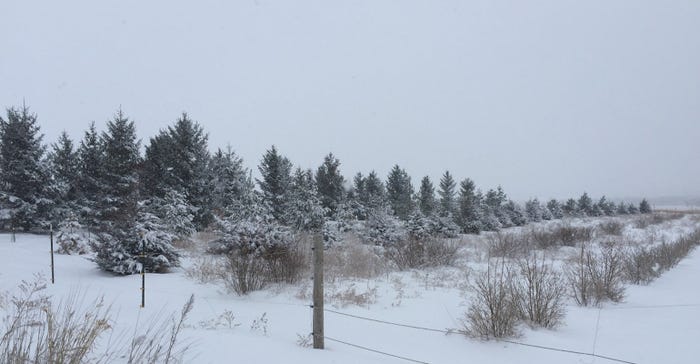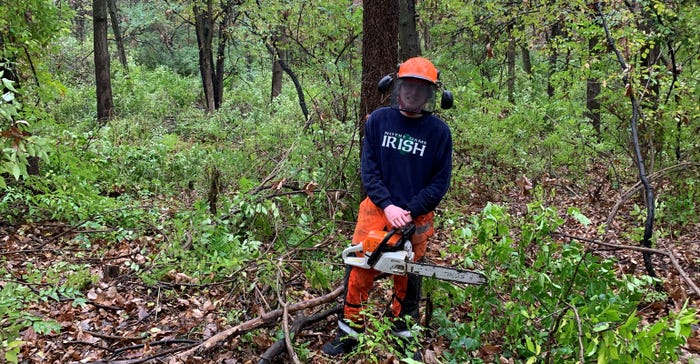April 5, 2022

Iowa was once primarily prairie, but forests, woodlands and savannas represented a surprising 20% of Iowa’s landcover. More than 150 years of agricultural production and urban development has changed the landscape and the population of trees across the state, reducing forests to about 8% of Iowa’s landcover. Yet on the farm, beyond specific practical applications, trees are generally ignored — and sometimes reviled.
Billy Beck, Iowa State University Extension forestry specialist, has been trying to get a grasp on what farmers and landowners think about trees, and what they might need to make forest and tree management a part of their operational planning.
“There is a saying that any plant growing where you don’t want it is a weed,” Beck said. “This applies to trees on a farm as well as dandelions in the yard. Having a plan for where one tree or a hundred will add value to the farm is a huge step toward seeing trees as planned assets, not a nuisance to be dealt with.”
Looking for feedback and input regarding tree planning, Beck attended the Iowa Learning Farms Leadership Circle conference in February, where some 21 conservation-minded farmers and landowners gathered to provide ideas and feedback to ISU Extension and agency leaders from around the state.
Beck asked the group about formal forest management or windbreak plans. Only one farmer raised a hand and replied they had about 100 acres under active timber management. Other respondents mentioned that:
Trees are part of the working landscape but not actively managed
Tree planning is more of an afterthought than reality.
Beyond windbreaks, trees are not a priority.
Trees are a nuisance that must be eradicated from crop fields.

NATIVE SPECIES: Planting native species of trees, when possible, will benefit your farm in the long term. Nonnative windbreak spruce is in severe decline due to needle cast fungus. Likewise, nonnative conifers, such as blue, white and Black Hills spruce, frequently exhibit low vigor and are prone to disease.
“I have learned a great deal about how trees are perceived, utilized and managed at the farm scale in recent conversations with farmers,” Beck said. “In general, beyond windbreaks, there seems to be very limited planning on most farms. And from my own observations — between age, limited maintenance and the effects of back-to-back derechos — most of the windbreaks in Iowa are in dire need of renovation and even replacement.”
CRP rules prohibit trees
Several of the conference participants referred to Conservation Reserve Program rules that specifically prohibit trees to grow on reserved land. One farmer said, “Farmers are taught by CRP to eradicate trees. No trees allowed — ever!” And another said, “As row crop farmers, we rip out every tree.”
“It’s surprising to most producers that there are CRP practices that encourage trees — notably, Tree Planting (CP-3), Riparian Forest Buffers (CP-22) and Bottomland Timber Establishment (CP-31),” Beck said. “We want to make sure farmers can reap the benefits of forested areas that complement the workings of the farm, but it is clear that there are significant hurdles to overcome. Understanding the needs and gaps in knowledge is the first step in creating and promoting good planning, planting and management practices.”

PROPER MANAGEMENT: When properly planned, placed and maintained, tree resources such as this windbreak may provide numerous benefits to the overall farm enterprise, including diversified income, crop and livestock protection, and wildlife habitat.
One thing identified in his conversations is the need for better access to information and planning resources. In the Leadership Circle meeting, needs mentioned included:
species selection advice
windbreak and forest maintenance
long-term economic planning advice
list of professional forester and nurseries for advice
As noted by one farmer, “We need a way to make a plan that spans over a long period — even decades. We plant corn and beans for this year, but planting trees is a multiple-generation proposition.”
More than windbreaks
It is generally accepted that windbreaks along field edges protect crops and improve yields. One challenge for foresters like Beck is moving the planning conversation beyond this singular application to realize additional benefits.
Noting that the derecho of 2020 did substantial damage to windbreaks on farms across the state, Beck commented, “Rather than letting nature fill in the gaps, aiding these trees and windbreaks in recovery should be a prescriptive and planned process.”
Foresters also stress that trees can offer multiple benefits in many different areas of the farm, including locations near buildings, pastures, streams and ponds.
“Windbreaks are important, but trees also help prevent soil erosion, stabilize streambanks, provide shade for livestock [and] habitat for wildlife, and assist in slowing the flow of nutrients from farm fields into waterways,” Beck said. “And even though trees and woodlands can offer opportunities for diversified income, it is sometimes an abstract connection between these intrinsic benefits and dollars and cents for the farmer.”

RID INVASIVE PLANTS: Lack of forest and woodlot management leads to the proliferation of unwanted trees and shrubs, such as invasive, nonnative honeysuckle. Note, all green vegetation seen in the photo is nonnative honeysuckle.
Beck acknowledged much work needs to be done to change perceptions about trees among many farmers and landowners.
“We are just scratching the surface of a complex issue that has a very longtime horizon,” Beck concluded. “It should be interesting to see where we stand in two, five and 10 years. My hope is that there will be a steady improvement in the health and diversity of forests and trees that are integral to farming, conservation and recreation.”
Ripley is manager of Iowa Learning Farms and a Water Rocks! conservation outreach specialist.
About the Author(s)
You May Also Like




